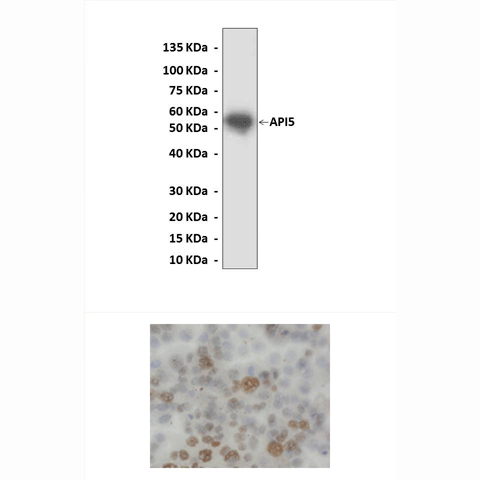Anti-API5: Rabbit Apoptosis Inhibitor-5 Antibody |
 |
BACKGROUND The apoptosis inhibitor-5 [API5; antiapoptosis clone 11 (AAC-11); fibroblast growth factor-2 (FGF2)-interacting factor (FIF)] is a 504-aa nuclear protein whose expression has been shown to prevent apoptosis after growth factor deprivation. It was shown that its antiapoptotic action seems to be mediated, at least in part, by the suppression of the transcription factor E2F1-induced apoptosis. Moreover, it was also reported that API5 interacts with, and negatively regulates Acinus, a protein involved in apoptotic DNA fragmentation. API5 can form homo-oligomers, through a leucine-zipper (LZ) motif, and oligomerization-deficient mutants of AAC-11 can no longer inhibit apoptosis nor interact with Acinus.1 The API5gene has been shown to be highly expressed in multiple cancer cell lines as well as in some metastatic lymph node tissues and in B-cell chronic lymphoid leukemia. API5 expression seems to confer a poor outcome in subgroups of patients with non-small cell lung carcinoma, whereas its depletion seems to be tumour cell lethal under condition of low-serum stress. Interestingly, API5 overexpression has been reported to promote both cervical cancer cells growth and invasiveness. Combined, these observations implicate API5 as a putative metastatic oncogene and suggest that API5 could constitute a therapeutic target in cancer.2
REFERENCES
1. Rigou, P. et al: EMBO J. 28:1576-88, 2009
2. Faye, A. & Poyet, J-L.: Expert Opin. Therapeut. Targets 14:57-65, 2010)
2. Faye, A. & Poyet, J-L.: Expert Opin. Therapeut. Targets 14:57-65, 2010)
Products are for research use only. They are not intended for human, animal, or diagnostic applications.
Параметры
Cat.No.: | CA1009 |
Antigen: | Short peptide from human API5 sequence. |
Isotype: | Rabbit IgG |
Species & predicted species cross- reactivity ( ): | Human, Rat |
Applications & Suggested starting dilutions:* | WB 1:1000 IP n/d IHC 1:50 - 1:200 ICC n/d FACS n/d |
Predicted Molecular Weight of protein: | 51 kDa |
Specificity/Sensitivity: | Detects endogenous levels of API5 proteins without cross-reactivity with other family members. |
Storage: | Store at -20°C, 4°C for frequent use. Avoid repeated freeze-thaw cycles. |
*Optimal working dilutions must be determined by end user.
Документы
Информация представлена исключительно в ознакомительных целях и ни при каких условиях не является публичной офертой








